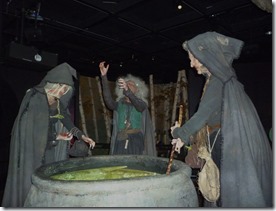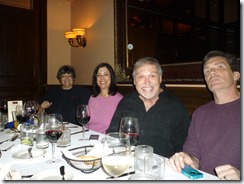Royal Princess Ship Review
Dec. 8 – 15, 2013
Itinerary: Princess Cays, St. Thomas, and St. Maarten
The Pros
We thought the entertainment and music on this ship were excellent. You could go from one show to another each evening, and the lounges held different music groups nightly. I would like more concert level performers. This cruise had Ray Coussins, a pianist for Frank Sinatra. He had his own show, and he played in the lounges. Down in the central atrium is a dance floor that always has a band playing there. Unlike other ships which are Deadsville at night, this one has plenty to do. You could always go to Movies Under The Stars, a wide-screen movie screen showing popular films each night by the pool.


Speaking of movies, I loved the widescreen TV mounted on our wall in the stateroom. I got to watch two movies I’d been wanting to see: Austenland (a romantic comedy about a modern woman who gets immersed in a Jane Austen experience at a themed attraction) and Disney’s Brave. The only disadvantages are the lack of menu controls and no close captioned option for the hearing-impaired.
We enjoyed the breakfast selections at the buffet. There is an omelet station if you can find it, but otherwise fried eggs, quiche, breakfast sandwiches, and other egg concoctions are available at the Horizon Court. So are fruits, smoked fish, pastries, waffles and pancakes, and more. I loved having the fried eggs available without asking and wish other cruise lines would adopt this practice.




Dinner menu choices were generally good. The alternate selections included shrimp cocktail, Caesar salad, plus beef medallions, grilled salmon, chicken, and more. Vegetarian entrees were offered each night at dinner and seemed appealing. There were always appetizers, soups, pasta, entrees, and dessert.
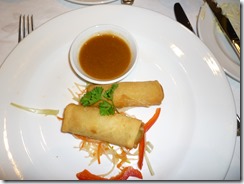


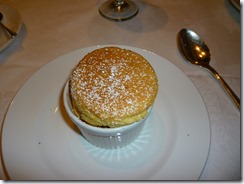
Dessert selections surpass other ships we’ve been on. At the Horizon Court, there’s a separate Pastry station with all kinds of pastries, cookies, puddings, and other creations. However, our dinner table mate complained that they only have one sugar-free selection per day. Being diabetic, she would have liked more choices.

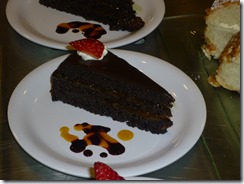


And since I’m a foodie, I enjoyed the cooking class and free galley tour. I was also thrilled that this cruise line still offers Baked Alaska on the last night.


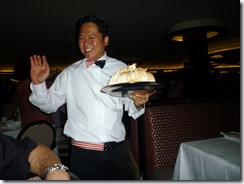

Storage space in the cabins was adequate even though the staterooms themselves are small. We had plenty of room to stash our luggage upright in the closet area instead of having to shove the pieces under our beds.
The shower space is an improvement, with a ledge for putting products or for aiding a lady in shaving her legs. On other ships, you have to stick your foot in the sink to do the job. This larger space was much appreciated.
Blackout drapes are very good. No lights shine in your eyes at night like on one of our other cruises, where we faced the door peephole and light streamed in like a beacon. This cabin was sufficiently dark and the temperature comfortable. Nor did I hear our neighbors except when they went out on the balcony.

We didn’t have many children on this cruise that saw an average age group well into the sixties, but there is an adults-only Retreat area that’s quite pleasant. For a daily fee, you can rent a covered cabana or pay for the more exclusive Sanctuary enclave.

The Cons
The bedding (i.e. pillows and comforters) didn’t seem as comfortable as on other ships. The pillows seemed too large, so you could get a crick in your neck with two, but one alone was too flat.
Elevator break-downs are common, and the elevator capacity is much smaller than on other ships.
The lack of a central stairway is highly annoying. One exists, but it’s for crew only. You have to take the elevators mid-ship or else walk aft or forward to reach the stairways.
Our room safe failed during our stay, and we had to call maintenance to change the four AA batteries that power the thing. It was an inconvenience, but service was prompt.
You’ll miss the outdoor promenade deck that goes all the way around a ship under cover on deck 4 or 5. This ship has a few seating areas on this level but they end. If you want to walk all the way around, you have to go at the pool deck or higher and be in the sun.
I would prefer a glass shower door to an unsanitary curtain.
The four rows of rear seats in the Princess Theatre need to be tiered. Seats are crammed into the theatre with central aisles only and no drink holders.
Our dining room service was very slow, but that may be the fault of our assistant waiter who did nothing except carry the meal orders from the dining room. Our waiter refilled the water glasses at our request, and he never once asked if we wanted more rolls or went out of his way to do anything special.
Cabins are very small with no sofas like in the balcony staterooms on RCCL. The standard balconies are even smaller. They barely fit two chairs and a cheap table.
<><><>
Ports of Call included a barbecue beach lunch at Princess Cays in the Bahamas, St. Thomas and St. Maarten. I’ve written about these before in previous posts and didn’t do anything new this time except walk around, shop, and lunch in town. Look under Cruising in my blog Archives if you want to catch up on prior voyages. We had lunch in the Greenhouse restaurant at both locations. The one at St. Maarten had free WiFi if you sat inside, which still has an open air view of the water.


On our last day at sea, we went out on deck in the morning after a rainstorm to see a brilliant rainbow stretching all the way across the sky. How fantastic is this, folks?


<><><>
View my Photo Album of the Royal Princess here: http://bit.ly/1j9jJct
View my Videos here: http://bit.ly/1djD5nY






